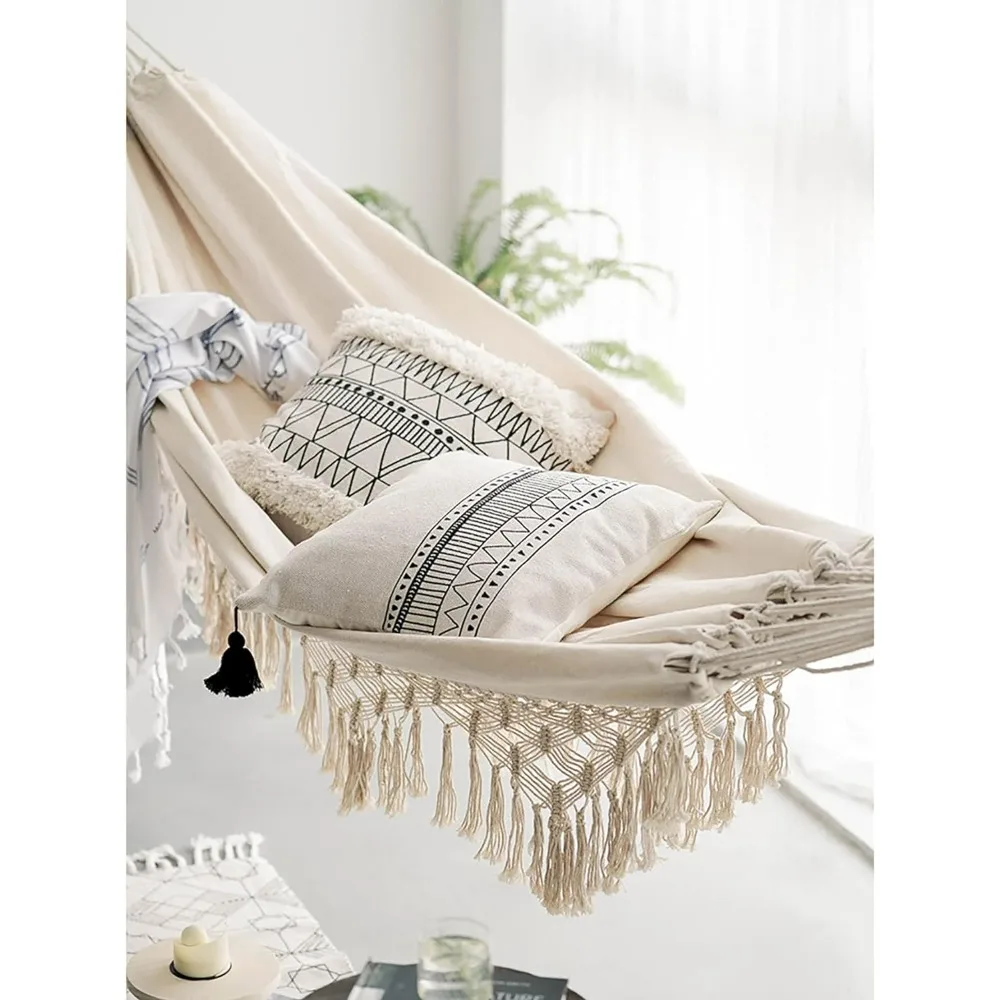Introduction
Sleeping in a hammock is an experience that combines the soothing aspects of nature with the comforting sway that can lull anyone into a peaceful sleep. However, there are certain challenges that come with hammock sleeping, especially for those new to the practice. This article serves as a comprehensive guide on how to sleep in a hammock, offering tips and tricks to ensure you have a restful night outdoors. Whether you’re a seasoned camper or a novice looking to try something new, this guide has all the insights you need for a comfortable hammock sleeping experience.

Choosing the Right Hammock
The first step to a restful night in a hammock is choosing the right one. Not all hammocks are created equal, and various factors such as size, material, and features can significantly impact your comfort. Look for a hammock that offers ample space; generally, a hammock that is at least 2 feet longer than your height is ideal. A wider hammock can also provide more room for movement and different sleeping positions.
Material is another crucial consideration. Cotton hammocks are soft and breathable, making them great for warmer climates, but they can become heavy when wet and take longer to dry. On the other hand, nylon hammocks are lightweight, quick-drying, and durable, making them more suitable for outdoor adventures. Some hammocks also come with integrated bug nets and rain fly options, which can provide added comfort and protection from the elements.
Setting Up Your Hammock
Proper setup is essential for a comfortable hammock sleeping experience. The first thing to consider is the location. Find two strong, healthy trees that are roughly 12-15 feet apart. Avoid trees with signs of decay or damage, as they might not support the weight. Once you’ve found suitable trees, wrap the suspension straps around them at about head height. Make sure the straps are secured and the hammock is hung with a slight sag.
The angle at which your hammock hangs is critical. Aim for a 30-degree angle between the suspension straps and the ground. This angle allows for a comfortable, slightly reclined position, reducing pressure on your back and ensuring a restful sleep. A common mistake is to hang the hammock too taut, which can cause discomfort and make it difficult to lie flat.
Finding the Best Sleeping Position
The way you position yourself in the hammock can determine how well you sleep. Many people mistakenly lie straight down the middle, which can cause a “banana” shape and lead to discomfort. Instead, try lying diagonally across the hammock. This flattens out the fabric and offers a more natural sleeping position that mimics lying on a bed.
For those who prefer back sleeping, the diagonal position distributes your weight more evenly and reduces pressure points. Side sleepers can also find comfort in a hammock, although it might take some adjustments. Elevating your knees slightly or using a small pillow between your knees can help maintain spinal alignment and comfort. Some hammocks even come with specific features or accessories, like foot boxes or side tie-outs, designed to enhance different sleeping positions.
If you prefer sleeping on your stomach, a wider hammock can provide enough room to turn over and lie comfortably. Always make sure you are well-supported and that the weight distribution feels balanced. Experimenting with different positions during your first few nights can help you find the perfect setup and maximize your comfort.
Using the Right Accessories
Accessories can significantly enhance your hammock sleeping experience. A quality sleeping pad or underquilt is essential for insulation, particularly in cooler weather. While sleeping pads provide a barrier between you and the cold air under the hammock, underquilts attach beneath the hammock, offering more consistent insulation without compressing under your weight.
A good sleeping bag or top quilt will also help maintain warmth. Choose one that’s appropriate for the climate you’ll be sleeping in. Mummy-style sleeping bags are great for colder conditions, while lightweight quilts are more suitable for warmer nights. Additionally, use a small pillow or a rolled-up piece of clothing to support your neck and head. Inflatable travel pillows can be a convenient and adjustable option.
For added protection and comfort, consider an integrated bug net, especially if you’re camping in an area with mosquitoes or other insects. A rain fly or tarp is another valuable accessory, providing protection from rain, wind, and even morning dew. Ensure that the tarp is large enough to cover your hammock and is set up at an appropriate angle to direct water away from your sleeping area. These accessories not only enhance comfort but also ensure a more secure and protected outdoor sleeping experience.

Clothing and Bedding
What you wear and the bedding you use can have a significant impact on your comfort while sleeping in a hammock. Opt for moisture-wicking fabrics that can keep you dry and comfortable throughout the night. Avoid cotton as it absorbs moisture and can make you feel clammy. Instead, choose synthetic or merino wool options that regulate temperature and manage moisture effectively.
Layering is key to staying warm in a hammock. Start with a base layer to wick away moisture, add an insulating layer for warmth, and finish with a windproof and waterproof outer layer if necessary. Ensure your feet and hands are kept warm with appropriate socks and gloves. Thermal or fleece liners can provide added warmth on particularly cold nights.
Managing Temperature and Weather Conditions
Temperature control is one of the biggest challenges when it comes to sleeping outdoors, and hammocks are no exception. In warm weather, the breathable fabric of the hammock can help keep you cool. However, in cooler conditions, you’ll need extra insulation. As mentioned earlier, an underquilt or sleeping pad provides essential insulation beneath you, while a sleeping bag or top quilt keeps you warm from above.
In cold weather, it’s crucial to trap heat while also managing moisture. Utilize vapour barriers if necessary, and ensure your sleeping setup includes multiple layers that can be adjusted according to temperature changes. Be mindful of condensation buildup, which can dampen your insulation and make you cold. Proper ventilation and adjusting your layers can help manage this.
Weather conditions can change quickly outdoors, so being prepared for rain and wind is essential. A rain fly or tarp set up correctly will protect you from precipitation and wind. Ensure the tarp extends well beyond the edges of your hammock to prevent water from seeping in. Positioning your hammock so that one side is lower can create a windbreak, offering further protection. Always check the weather forecast before your trip and prepare accordingly to ensure a comfortable and dry sleep.
Staying Safe While Sleeping in a Hammock
Safety is paramount when sleeping in a hammock, especially in an outdoor setting. Ensure that your hammock and suspension system are of high quality and rated for the appropriate weight. Inspect all components for wear and tear before each use. Trees should be healthy and strong enough to support your weight without risk of breaking. Avoid trees with signs of rot, infestation, or instability.
Be mindful of your surroundings. Set up your hammock in a flat, clear area away from potential hazards like falling branches, animal trails, or water sources that could flood. Keep your sleeping area organized to prevent tripping over gear in the dark. A small, easily accessible light source like a headlamp or flashlight is essential for nighttime visibility.
In bear country or areas with active wildlife, follow local guidelines for food storage and campsite cleanliness. Store all food away from your sleeping area in bear-proof containers or hang it in a bear bag. Familiarize yourself with campground safety protocols and always have a first-aid kit on hand. By taking these precautions, you’ll ensure a safe and enjoyable hammock sleeping experience.
Tips for Beginners
For those new to hammock sleeping, starting with a few key tips can make the transition smoother and more enjoyable. First, practice setting up your hammock at home or in a local park before venturing into the wilderness. This will help you get familiar with the equipment and make any necessary adjustments.
Invest in high-quality gear from reputable brands. While it might be tempting to go for cheaper options, the quality of your hammock, suspension system, and accessories can significantly impact your comfort and safety. Look for reviews and recommendations from experienced hammock campers to guide your purchases.
Start by using your hammock for naps or relaxing during the day. This will give you a feel for the best positions and setups without committing to a full night’s sleep. Gradually build up to overnight stays once you’re confident in your setup and gear.

Conclusion
Mastering how to sleep in a hammock can transform your outdoor experiences, offering a unique combination of comfort, convenience, and connection to nature. From selecting the right hammock and perfecting your setup to managing temperature and overcoming common challenges, this comprehensive guide provides all the insights you need for a restful night outdoors.
By understanding the nuances of hammock sleeping and incorporating the tips and tricks shared here, you can ensure a comfortable and safe experience, whether you’re camping, hiking, or simply relaxing in your backyard. Embrace the benefits of hammock sleeping and enjoy the freedom and relaxation it brings to your outdoor adventures. With a little practice and the right gear, you’ll be well on your way to mastering this enjoyable and rewarding way to sleep under the stars.
